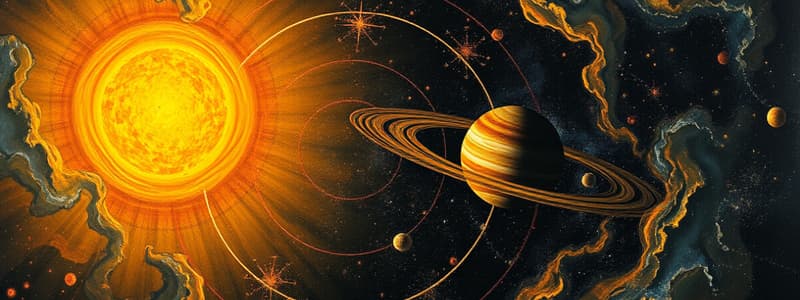Podcast
Questions and Answers
What is the first step in the formation of the solar system according to the Nebular Theory?
What is the first step in the formation of the solar system according to the Nebular Theory?
- The solar wind blows out the rest of the gas
- The sun is formed at the center
- Planets collide and grow
- The cloud of dust and gas contracts (correct)
All of the planets orbit the sun in different directions.
All of the planets orbit the sun in different directions.
False (B)
What are the two main forces that keep planets in orbit?
What are the two main forces that keep planets in orbit?
Gravity and Inertia
A comet is a small body made out of dust, rock, gas, and ___ .
A comet is a small body made out of dust, rock, gas, and ___ .
Match the following planets with their characteristics:
Match the following planets with their characteristics:
Which of the following statements is true regarding the planets closest to the sun?
Which of the following statements is true regarding the planets closest to the sun?
The tallest mountain on Mars is called ___ .
The tallest mountain on Mars is called ___ .
What is the center of our solar system?
What is the center of our solar system?
An asteroid is a small piece of rock smaller than a comet.
An asteroid is a small piece of rock smaller than a comet.
What covers Saturn's rings?
What covers Saturn's rings?
What are the two types of planets in our solar system?
What are the two types of planets in our solar system?
Flashcards are hidden until you start studying
Study Notes
Origin of the Solar System
- Theories of solar system formation must explain key facts such as each planet's isolation and the nearly circular orbits.
- Planetary orbits lie in a common plane and rotate in the same direction as the Sun's rotation.
- The Nebular Theory proposes that the solar system originated from a collapsing cloud of dust and gas, leading to the Sun's formation at the center.
Nebular Theory
- The interstellar cloud collapses under its own gravity, forming protoplanetary nebulae.
- Angular momentum conservation leads the collapsing cloud to spin faster and flatten into a disk.
- This theory accounts for major solar system characteristics and exceptions.
Condensation Theory
- The gas in the nebula does not clump into planets without interstellar dust acting as condensation nuclei.
- Dust grains, remnants of old stars, allow other atoms to attach and start the planet formation process.
Characteristics of the Solar System
- All planets orbit in the same direction and plane, with closer planets being smaller and rocky, while outer planets are larger and gas-rich.
- Most moons orbit their planets in the same direction as their planets orbit the Sun.
- The oldest meteorites date to about 4.566 billion years old.
Galaxies and the Milky Way
- The Sun is one of trillions of stars in the universe, grouped into galaxies.
- The solar system is part of the Milky Way galaxy.
Spinning Planets: Rotation and Revolution
- The period of rotation is the time taken for a planet to complete one spin (e.g., 1 Earth day).
- The period of revolution is the time taken to orbit the sun once (e.g., 1 Earth year).
Inner Planets (Terrestrial Planets)
- Mercury: Fastest orbit, extreme temperature variations, weighs 38% less than on Earth.
- Venus: High atmospheric pressure, volcanic activity, known as the "evening star," and rotates in the opposite direction to Earth.
- Earth: Perfect temperature range supports liquid water, unique for life, 365-day revolution.
- Mars: Thin atmosphere, evidence of historical water, features the tallest volcano (Olympus Mons), and has two moons.
Outer Planets (Gas Giants)
- Jupiter: Largest planet, features a massive storm (Great Red Spot), short rotation period.
- Saturn: Known for its extensive ring system, largest rings made of icy particles, 18 moons.
- Uranus: Unique axial tilt of 90 degrees, blue-green color, 21 moons named after Shakespearean works.
- Neptune: Discovered in 1846, visible cloud belts, has seven thin rings and eight moons.
Differences in Planet Types
- Giant (Jovian) Planets: Composed mainly of gases, form quickly, and have massive cores.
- Terrestrial (Earth-like) Planets: Composed of solid material, form slower, and have rocky cores.
Gravity and Inertia
- Gravity pulls objects toward each other; inertia is the tendency of objects in motion to remain in motion.
- Both forces work together to maintain the orbits of planets and moons within the solar system.
Other Space Objects
- Comets: Composed of dust, rock, gas, and ice; originate from distant regions.
- Asteroids: Large irregularly shaped rocks primarily in the asteroid belt between Mars and Jupiter; can collide with other bodies and create craters.
- Meteoroids: Small rock or dust particles; when entering Earth's atmosphere, they produce meteors, and if they land, they become meteorites.
Studying That Suits You
Use AI to generate personalized quizzes and flashcards to suit your learning preferences.




